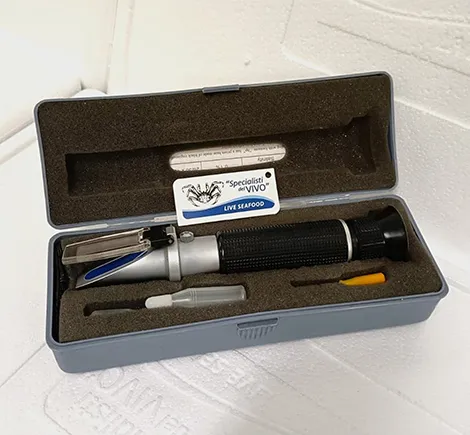
Name
Refractometer.Description
The refractometer is an optical instrument used to quantitatively detect the presence of solutes in a solution: in our case, the amount of salts dissolved in the water in which live crustaceans are housed. Its operation is based on the different degree of refraction of light through the solution depending on the amount of dissolved salts: using the instrument it is therefore possible to associate different degrees of refraction of light, visible in the instrument as shifts in the dividing line between the light area and the dark area, with a scale of values visible in the eyepiece.Quantity and packaging
Each individual refractometer is stored in its own plastic case, padded with soft sponge.Method of use
The scale on the refractometer refers to salinity expressed as a value per thousand, thus referring to the fraction in grams of salts dissolved in a thousand grams of water: this scale is equivalent to the density of seawater, which on average is around 35‰ depending on the geographical area; in the Mediterranean, for example, where water circulation is lower as it is an enclosed sea, the average value is around 37‰, i.e. afraction of 37 grams of salts dissolved in a thousand grams of water, 37 g/kg.Usually housed crustaceans live well in an average salinity range between 1024 and 1028, distinguishing for convenience two regimes associated with water temperature according to species:
1) “cold water” regime: temperature range 4-6°C, density range 1024-1026, used for American lobsters (American understood as the species Homarus americanus and not as a product distinction), king crab, langoustines, snow crab;
2) "warm water" regime: temperature range 8-15°C, density range 1027-1029, used for spiny lobsters (except tropical species, which require higher temperatures), slipper lobsters, European lobsters, spider crabs, edible crabs.
Once you have purchased your new refractometer, you need to calibrate it in order to use it. Usually everything you need is already in the package: a vial of the appropriate solution with its dropper and a small screwdriver needed to turn the calibration screw. Making sure that the prism (the front transparent section on which the liquid sample to be tested is deposited) and the lid are well cleaned, deposit a few drops of the solution on the clean prism, carefully close the lid making sure that no air bubbles remain inside and then point the instrument towards a sufficiently strong light source (or even the sun). Bring the lens close to the eye and turn the focus ring to make the scale sharp and readable. Then check the point where the separation between dark and bright area occurs: using the screwdriver, turn the screw until this separation line coincides exactly with zero.
If there is no vial of solution, use distilled water following the same method. It is very important, for the measurement to be correct, that the liquid with which the calibration is performed and the refractometer itself have the same temperature (given the automatic temperature calibration range of this model between 10°C and 30°C, preferably below 20°C).
Storage conditions
After use, gently dry the entire instrument with soft paper towels and store it in the closed case, protected from shocks.Updated
REV. n° 1 dated 08/01/2024.Ammonia Test
Leaflet
Net
Leaflet
Perlon Cloth
Leaflet
Crustacean Tongs
Leaflet
Salt
Leaflet
Gel Pack
Leaflet
Refractometer
Leaflet
